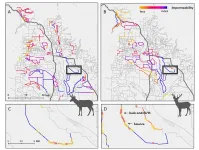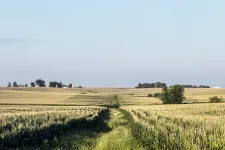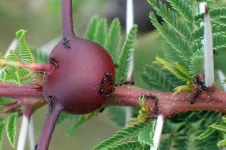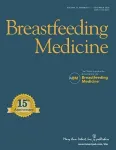(Press-News.org) Berkeley -- Each year, thousands of migratory mule deer and pronghorn antelope journey northwest from their winter homes in the Green River Basin, a grassland valley in western Wyoming, to their summer homes in the mountainous landscape near Grand Teton National Park.
But to reach their destination, these ungulates must successfully navigate the more than 6,000 kilometers (3,728 miles) of fencing that crisscrosses the region. That's enough distance to span nearly twice the length of the U.S.-Mexico border.
In a new study, wildlife biologists at the University of California, Berkeley, combined GPS location data of tagged mule deer and pronghorn with satellite imagery of fences to find out just how often these animals encounter fences, and what happens when they do. The results, published on Jan. 7 in the Journal of Applied Ecology, help pinpoint which fences pose the biggest barrier to ungulates trying to access their ideal habitat.
Along with the study, the team is also publishing a software package that will help wildlife managers around the world quickly analyze GPS tracking data to identify fences and other barriers that might be impeding the vital movements of animals.
"We need fences -- they help keep livestock safe, can help keep livestock and wildlife separate, and mark property boundaries," said Arthur Middleton, an assistant professor of wildlife management and policy at UC Berkeley and senior author of the paper. "So, the question becomes, how do you identify which fences are really important, and which are problematic from a wildlife standpoint, and then seek some way to mitigate the impacts?"
Fences don't always pose an insurmountable barrier to wildlife, and different species find different ways to get around them. Mule deer are willing to jump over fences that are low enough. Pronghorn antelope, however, are reluctant to jump over fences and instead must seek out areas where they can move underneath.
Wenjing Xu, a Ph.D. student at UC Berkeley and lead author of the paper, took these different behaviors into account when creating the software package that compares animal tracking data with fence maps. The program can categorize different types of behaviors that animals might engage in when they encounter a fence, such as quickly crossing over the fence, pacing back and forth along the fence, or turning around and walking away from the fence.
To understand how fences are impacting mule deer and pronghorn, Xu started by painstakingly comparing fencing maps from the federal Bureau of Land Management and the U.S. Forest Service with satellite imagery, adding in fences that were not included in the government surveys. When all the fences were accounted for, Xu was surprised at the sheer amount of fencing in the region.
"The total length of fences is really, really striking, especially with what we know about the different types of wide-ranging animals that live in that area," Xu said.
Xu then compared these maps to GPS tracking data that collected locations every two hours for 24 tagged female mule deer and 24 pronghorn antelope.
Each year, mule deer encountered fences an average of 119 times, Xu found. Pronghorn antelope encountered fences at more than twice that rate, about 248 times per year. About 40% of these fence encounters resulted in a change in the animals' behavior.
"Anybody who's spent time in the West knows you'll find a lot of fences. But, seeing such frequent encounters, 40% of which result in a failure to cross, is kind of mind-blowing -- especially when you multiply those numbers across whole populations and landscapes," Middleton said.
Some of these fences are currently being used by ranchers to protect livestock or mark property lines. Others are relics of a bygone era when sheep farming was popular in the state, Middleton said.
The best way to mitigate the impact of these fences on animal migration is to remove them, or to replace them with more "wildlife-friendly" fences that mule deer can jump over or that pronghorn can duck under. However, both of these options require money and labor. According to Xu, a recent fencing modification project in Wyoming spent more than $10,000 per mile of fencing to make the fences more permeable to pronghorn.
The software package developed by Xu is able to create maps that highlight the fences that pose the greatest impediment to animal movement, helping to prioritize fences to be modified or removed.
"There is such a strong need for this kind of data," Xu said. "Modifying fences is really, really expensive, and the amount of fencing that might need to be fixed is just so large. [Wildlife managers] really want to find ways to prioritize their resources."
Brandon Scurlock, a wildlife management coordinator for the Pinedale region of the Wyoming Game and Fish Department, is working to designate a protected migration "corridor" that connects the summer and winter ranges of pronghorn antelope in western Wyoming. Similar migration corridors for mule deer were established by the state earlier this year.
Scurlock's team is already using the study results to identify fences that might create barriers along these routes, and prioritize those for modification.
"It's been interesting noticing the characteristics of some of these fences that this study has pointed out as being not very permeable for Pronghorn," said Scurlock, who was not a member of the study team. "We recommend the bottom wire of a fence be at least 18 inches above the ground. And, when looking at some of the particularly bad fences that that these methods highlight, we almost invariably see that they have barbed wires that are too close to the ground."
One option for offsetting the cost of fence mitigation throughout this region, which is part of the Greater Yellowstone Ecosystem, could consist of imposing a small "conservation fee" on visitors to the area's parks, which include the extremely popular Yellowstone National Park and Grand Teton National Park. Middleton and co-authors, including Berkeley Law professor Holly Doremus, explored the feasibility of this approach in a study published last month in the journal Conservation Science and Practice.
"Fine-scale movement data has helped us see much further into animals' lives, including the challenges we've imposed," Middleton said. "I hope this work helps open people's eyes to the scale of fence effects. Our next steps are to better understand the actual biological cost that all these fence-related behavioral changes have on wildlife populations, and find ways to mitigate those effects at a really large scale."
INFORMATION:
Other co-authors of the paper are Nandintsetseg Dejid of the Senckenberg Biodiversity and Climate Research Centre (SBiK-F) in Frankfurt, Germany; Valentine Herrmann of the Smithsonian Conversation Biology Institute; and Hall Sawyer of Western Ecosystems Technology Inc.
This research was supported by the National Geographic Society (Grant/Award Number WW-100C-1), the Buffalo Bill Center of the West, the William and Flora Hewlett Foundation and the Greater Yellowstone Coalition, the Knobloch Family Foundation, the Smithsonian Conservation Biology Institute, and the German Federal Ministry of Education and Research (Grant/Award Number BMBF01LC1820A)
Curiosity has been found to play a role in our learning and emotional well-being, but due to the open-ended nature of how curiosity is actually practiced, measuring it is challenging. Psychological studies have attempted to gauge participants' curiosity through their engagement in specific activities, such as asking questions, playing trivia games, and gossiping. However, such methods focus on quantifying a person's curiosity rather than understanding the different ways it can be expressed.
Efforts to better understand what curiosity actually looks like for different people have underappreciated roots in the field of philosophy. Varying styles have been described with loose ...
A lurking threat that has stymied US corn growers for decades is now returning to the forefront: western corn rootworm. Sometimes referred to as the "billion-dollar bug," the species' tiny larvae chew through the roots of corn plants, causing devastating yield losses. In 2003, farmers began planting a genetically engineered variety of corn known as "Bt," which produces a protein toxic to the pest species - but by 2009, the billion-dollar bug had already evolved adaptations for resistance to the toxin.
A new study suggests that slowing the resurgence of western corn rootworm may require a larger-scale strategy than previously thought. The findings, ...
BOSTON - While investigating the underlying causes of a rare skin disorder, a researcher at Massachusetts General Hospital (MGH) discovered a previously unknown mechanism in the kidneys that is important for regulating levels of magnesium and calcium in the blood.
The discovery, described in the journal Cell Reports, highlights the role of a previously little-studied gene called KCTD1. The gene directs production of a protein that regulates the kidney's ability to reabsorb magnesium and calcium from urine and return it to the bloodstream.
A genetic mutation causing the loss of KCTD1 results in defects in nephrons, ...
You've heard of Old Faithful, the Yellowstone National Park geyser that erupts every hour or two, a geological phenomenon on a nearly predictable schedule.
Now, an international group of scientists who study space have discovered an astronomical "Old Faithful" - an eruption of light flashing about once every 114 days on a nearly predictable schedule. The researchers believe it is a tidal disruption event, a phenomenon that happens when a star gets so close to a black hole that the black hole "rips" away pieces of the star, causing the flare.
The team made the discovery using data from NASA and from a network of telescopes operated by The Ohio State University.
Their findings, presented today at the Astronomical Society's annual meeting and accepted for publication ...
Researchers have found a simple way to eliminate almost all sequencing errors produced by a widely used portable DNA sequencer, potentially enabling scientists working outside the lab to study and track microorganisms like the SARS-CoV-2 virus more efficiently.
Using special molecular tags, the team was able to reduce the five-to-15 per cent error rate of Oxford Nanopore Technologies' MinION device to less than 0.005 per cent -- even when sequencing many long stretches of DNA at a time.
"The MinION has revolutionized the field of genomics by freeing DNA sequencing from the confines of large laboratories," says Ryan Ziels, an ...
Scientists have used gene-editing advances to achieve a tenfold increase in the production of super-bug targeting formicamycin antibiotics.
The John Innes Centre researchers used the technology to create a new strain of Streptomyces formicae bacteria which over-produces the medically promising molecules.
Discovered within the last ten years, formicamycins have great potential because, under laboratory conditions, superbugs like MRSA do not become resistant to them.
However, Streptomyces formicae only produce the antibiotics in small quantities. This has made it difficult to scale up ...
ITHACA, NY - Invasive round goby fish have impacted fisheries in the Great Lakes and the Finger Lakes by competing with native species and eating the eggs of some species of game fish.
But the camouflaged bottom dwellers can be difficult to find and collect - especially when they first enter a new body of water and their numbers are low and they might be easier to remove.
In a proof-of-principle study, Cornell researchers describe a new technique in which they analyzed environmental DNA - or eDNA - from water samples in Cayuga Lake to gather nuanced information about the presence of these invasive fish.
The study, "Nuclear eDNA Estimates Population Allele Frequencies and Abundance in Experimental Mesocosms and Field Samples," was ...
In a large population-based family study, family history of kidney disease was strongly associated with increased risk of chronic kidney disease.
In this large population-based family study recently published in the American Journal of Kidney Diseases, researchers investigated the familial aggregation of CKD by comparing the risk of chronic kidney disease (CKD) in individuals with an affected first-degree relative to that in the general population. Participants with an affected first-degree relative were observed to have a threefold higher risk of CKD compared to that in the general population, independent of BMI, hypertension, diabetes, hypercholesterolemia, history of cardiovascular disease (CVD), and smoking status. ...
New Rochelle, NY, January 12, 2021--The Academy of Breastfeeding Medicine (ABM) does not recommend cessation of breastfeeding for individuals who are vaccinated against COVID-19. In a new statement, the ABM suggests that lactating women discuss the risks and benefits of vaccination with their health care provider, within the context of their risk of contracting COVID-19 and of developing severe disease, according to the peer-reviewed journal Breastfeeding Medicine. Click here to read the ABM statement now.
This is a challenging topic because the vaccine trials excluded lactating women. Thus, there are no clinical data regarding the safety ...
The body's immune system is the first line of defense against infections like bacteria, viruses or cancers. Some cancers, however, have developed the art of molecular deception to avoid destruction by the body's immune system. However, a University of Missouri researcher might have found a new way to help the body's immune system get past that deception and destroy the cancer.
"Normally, your body's immune cells are constantly on patrol to identify and destroy foreign entities in the body," said Yves Chabu, an assistant professor in the Division of Biological Sciences. "Normal cells put up a 'don't-eat-me' molecular ...





